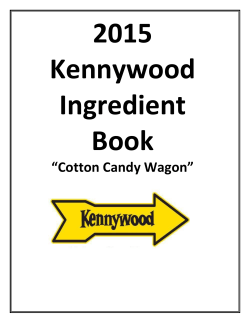
NMSU Extension Plant Sciences, Cotton Newsletter, April 2015
New Mexico State University Extension Plant Sciences Fiyin3490 Cotton Newsletter: Volume 6, Number 1 (April 2015) Fiyin3490 2015 Cotton – Planting Projections We are at the beginning of another growing season and many cotton growers in New Mexico have already prepared their fields in preparation for planting. The cotton industry has continued to suffer under fluctuating lint prices which has affected the decision of many farmers in the cotton belt to grow cotton. The price drop that was experienced last year has created uncertainty about the acreage that will go into cotton in New Mexico during 2015 season. According to USDA Cotton Outlook, the area planted to cotton in USA will likely reduce by 12% during the coming season (down from 11 million acres in 2014 to estimated 9.7 million acres in 2015). According to the National Cotton Council, about 9.3% reduction in cotton acreage is predicted for New Mexico (down from 43,000 acres in 2014 to estimated 39,000 acres in 2015). Please, send your comments and contributions to John Idowu (email: jidowu@nmsu.edu; phone: 575-646-2571. Previous editions of the Cotton Newsletter are posted on http://aces.nmsu.edu/ces/ifcpm/cottonproduction.html NEWSLETTER HIGHLIGHTS 2015 COTTON – PLANTING PROJECTIONS 2015 NM COTTON CONFERENCE REPORT NEW APHID PEST OF SORGHUM NEAR NEW MEXICO COTTON INCORPORATED NATURAL RESOURCE SURVEY COTTON PRICES 2015 New Mexico Cotton Conference Report The New Mexico Cotton Conference took place on January 14th, 2015 at the Ruidoso Convention Center, Ruidoso, NM. About 70 farmers and stakeholders attended the conference. Topics presented during the cotton conference included cotton economic prospects, pest and weed control in reduced tillage systems, weed control in cotton, potential insect pests for 2015 growing season, and glandless cotton research and production in New Mexico. Other topics covered included cotton breeding developments at NMSU, cotton ginning research update and NM cotton seed production and certification. Several industrial representatives also presented updates on new and current products available for cotton production. We thank our speakers/moderators for 2015. Our speakers/moderators included Mr. Doug Starr (Calcot); Mr. Dennis Neffendorf (Orthman Manufacturing); Dr. Carol Sutherland (NMSU); Mr. Woods Houghton (Eddy County, Ag. Agent); Mr. Greg Alpers (Dow AgroSciences); Dr. Jinfa Zhang (NMSU); Dr. Robert Flynn (NMSU); Dr. John Idowu (NMSU), Dr. Jane Pierce (NMSU) Dr. Tracey Carrillo (NMSU) Mr. Michael Ronquillo (NMSU) and Dr. Ed Hughs (USDA-ARS). We also appreciate the efforts of Dr. Patrick Sullivan and Mr. Bill Chambers of the NM Cotton Boll Weevil Control Committee for their help. We thank our sponsors who generously donated to make our 2015 meeting a success. Our donors for 2015 included Bayer CropScience, Dow AgroSciences-PhytoGen, Americot/NexGen Cotton, BASF, Calcot, Inc., Crop Production Services, All-TEX Seed, Dyna-Gro, Farm Credit of New Mexico, Gowan USA, Helena Chemical, Jess Smith, Mesa Farmers’ Cooperative, NMSU Seed Certification, Pecos Valley Implement/John Deere, South Plains Implement/John Deere and West Gaines Seed and Delinting. New Aphid Pest of Sorghum near New Mexico Cotton growers may be hearing about sugarcane aphid (Figure 1A) in the news. Sugarcane aphid is a new aphid pest of sorghum which will likely move into New Mexico this year. Sugarcane aphid does not attack cotton. It has expanded its diet to unfortunately include sorghum but more fortunately johnsongrass. A.) Sugarcane aphid B.) Yellow sugarcane aphid C.) Greenbug Figure 1. Pictures of A: Sugarcane aphid; B: Yellow sugarcane aphid; and C: Greenbug Over the last year the sugarcane aphid moved from south Texas to the Panhandle, and last year it was spotted northwest of Lubbock, near Plainview, Texas and Amarillo. It was also collected in Oldam County, Texas right on the border of New Mexico. It will likely move into New Mexico sometime this season. It likely did not overwinter this far north but will migrate up from somewhere in south Texas where it can overwinter. As soon as anyone spots the aphid, please let NMSU extension agents or specialists know, so that we can work with NMDA on an application for a section 18 for “Transform” which is the most effective insecticide. Sugarcane aphid looks similar to some other sorghum aphids, particularly yellow sugarcane aphid (Figure 1B) and greenbug (Figure 1C). However it is easy to distinguish the three species. Unlike sugarcane aphid, yellow sugarcane aphid has numerous hairs on its back and the greenbug has a green stripe down its back. With this pest, growers can see yield losses of up to 25-50 percent. Some fields have been so bad that growers have abandoned them. One of the big problems is when the sticky secretions from the aphids clog harvesting equipment. Fortunately, if an insecticide is applied at the recommended economic threshold of 50-125 aphids per leaf, growers can generally see good control with just one application. (Report by Dr. Jane Pierce, Entomologist, New Mexico State University) 2 Cotton Incorporated Natural Resource Survey Cotton Incorporated has initiated a Natural Resource Survey to help prioritize Cotton Incorporated research funding and identify the significant gains that producers have made in the last 5 years in lowering their environmental footprint. Unfortunately, we do not yet have enough participants from New Mexico who have completed this survey. The survey is very important to document good environmental stewardship practiced by cotton growers of New Mexico and other cotton growing States. We therefore want to use this opportunity to call on our cotton growers in New Mexico to participate in this survey. This survey can be done online by visiting: www.cottoninc.com/AgSurvey The survey is completely anonymous and should only take about twenty minutes to complete. If you have any question about the survey, you can email AgSurvey@cottoninc.com or call 919-6782220. Cotton Prices: 2014/2015 2014 January February March April May June July August September October November December Average 2015 Upland Cotton "A" Index* ELS (Pima) Spot Price* Upland Cotton "A" Index* ELS (Pima) Spot Price* 90.96 94.05 96.95 94.20 92.71 90.90 83.84 74.00 73.38 70.34 67.56 68.30 83.09 161.00 161.00 161.80 163.60 166.50 166.50 166.50 166.50 166.50 166.50 162.00 158.00 163.80 67.35 69.84 147.70 143.00 68.59 145.30 *Source: National Cotton Council of America and prices in (cents/pound). Publication Team: John Idowu (jidowu@nmsu.edu); Tracey Carrillo (tcarrill@nmsu.edu); Jinfa Zhang (jinzhang@nmsu.edu); Robert Flynn (rflynn@nmsu.edu); and Jane Pierce (japierce@nmsu.edu). ________________________, John Idowu, Extension Agronomist, New Mexico State University is an equal opportunity employer. All programs are available to everyone regardless of race, color, religion, sex, age, handicap or national origin. New Mexico State University and U.S. Department of Agriculture cooperating. 3
© Copyright 2025










